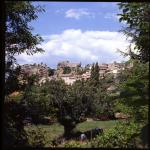|
Premier PC-90 |
Manufactured or assembled in Taïwan from (Circa) 1985 to (After) 1985.
Index of rarity in France: Infrequent (among non-specialized garage sales)
Inventory number: 8340
See the complete technical specifications
Chronology of cameras Premier
The cameras manufactured by Formosa Plastics Corporation are recognizable by the adhesive label marked "FPC Quality Passed." The problem is that this label easily peels off. The markings on the lens cannot help with identification because the same ones are found on cameras manufactured by Ouyama, suggesting that the lens is a common subcontract among several manufacturers in Taiwan. These markings are fanciful, using a fictitious serial number. They sometimes suggest functions that do not exist. For example, "Auto Fix focus" simply means there is no focus adjustment; it is a fixed focus. The word "Auto" is there to deceive.
One can attempt to determine main types among this production. It is noticed that the differences between two types are sometimes minimal. Dating is very difficult, although there is an evolution in shapes to follow the design of major brands.
To add to the confusion, the cameras bear various commercial trademarks, which are mostly hollow shells. The same model name can be used for different devices (e.g., Licom MXF-700). Some models bear well-known brands because they have been used for advertising purposes (e.g., Time). Other names, such as Nikanon, are only there for their resemblance to major brands like Nikon and Canon.
| Markings on lens | # on lens | |||
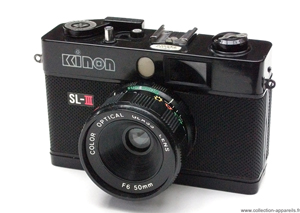 Like a Haking camera Like a Haking cameraOval window above the lens, serving no purpose |
Kinon SL-III |
 |
Color Optical Glass Lens F 6 50 mm |
|
 Opaque window in line with the lens (non-functional) Film advance lever |
Super II |  |
Optical Color Lens Auto Fix Focus 50 mm Lens 1:6 |
|
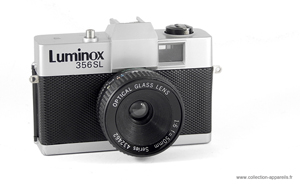 Off-center viewfinder Off-center viewfinderProminence of the bulge towards the front |
Luminox 356 SL |
Optical Glass Lens 1:6 f=50mm series 432462 |
432462 | |
| Premier PC-90 |
Optical Glass Lens series 198523 |
198523 | ||
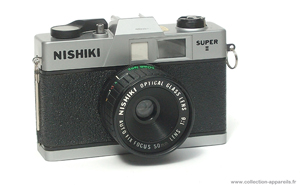 Off-center viewfinder Off-center viewfinderOpaque window in line with the lens (non-functional) Film advance lever |
Nishiki Super II |
Nishiki Optical Glass Lens Auto Fix Focus 50mm Lens 1:6 |
||
 Off-center viewfinder Off-center viewfinderOpaque window in line with the lens (non-functional) Frame counter on the top cover |
Optiflex NF-1 |
Optiflex Color Optical Glass Lens 1:6 f=50mm series 746277 |
746277 | |
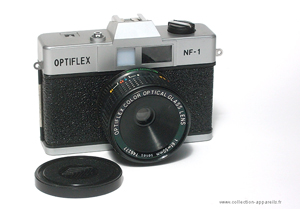 Off-center viewfinder Off-center viewfinderOpaque window aligned with the lens (non-functional) |
Optiflex NF-1 |
Optiflex Color Optical Glass Lens 1:6 f=50mm series 746277 |
746277 | |
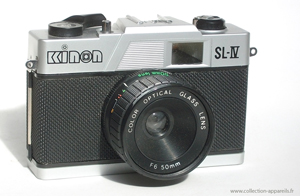 Film advance lever Film advance leverWide and low shoe base |
Kinon SL-IV |
Color Optical Glass Lens F 6 50 mm |
||
 Off-center viewfinder. Off-center viewfinder.Covered window under the bulge. The shutter release button is on a small platform. |
BW-7000 | Optical Color Lens Auto Fix Focus 50mm Lens 1:6 |
||
| UCC UC300 | ||||
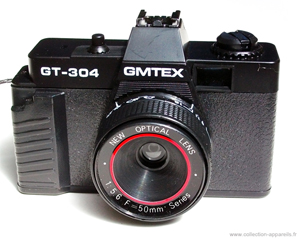 SLR-like form. Side viewfinder. Bulge for better grip. |
GMTEX GT-304 |  |
New Optical Lens 1:5.6 f 50 mm Series |
|
| Comax LT-002 |  |
Comax Optical Lens 1:6 f 50 mm Series |
||
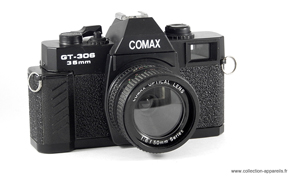 SLR-like shape. Side viewfinder. Bulge for better grip. Advance lever. |
Comax GT-306 | Comax Optical Lens 1:6 f 50 mm Series |
||
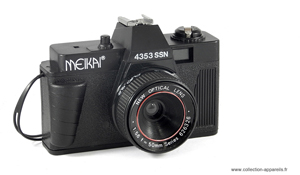 SLR-like shape. Side-mounted viewfinder. Bulge for improved grip. |
Meikai 4353 SSN | New Optical Lens 1:5,6 f=50 mm Series 626326 |
626326 | |
| ESC | ||||
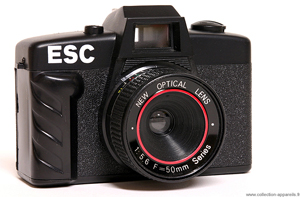 SLR-like shape. Viewfinder aligned with the lens. |
ESC | New Optical Lens 1:5,6 F = 50 mm Series |
||
| Roniflex X3000 | ||||
| GM Tex GT-304 | ||||
 Off-center viewfinder. Window obscured beneath the bulge. |
(Time) | Kinetic Optical Color Lens Auto Fix Focus 50mm Lens 1:6 |
||
| Nikanon RX-7 |
Nikanon Color Optical Glass Lens 1:6 f=50mm series 746277 |
746277 | ||
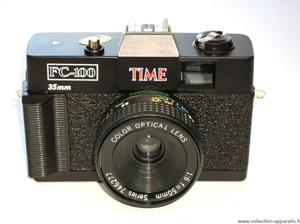 |
FC-100 (Time) |  |
Color Optical Lens 1:6 f=50mm series 746277 |
746277 |
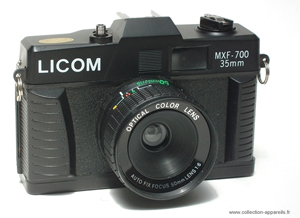 Finger rest at each end. Finger rest at each end.Off-center viewfinder. Window obscured beneath the bulge. |
Licom MXF-700 |
 |
Optical Glass Lens Auto Fix Focus 50mm Lens 1:6 |
|
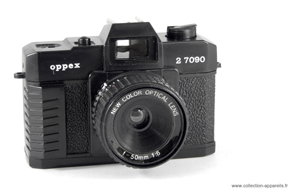 Reflex-like appearance. Viewfinder within the faux prism bulge. |
Oppex 2 7090 | New Color Optical Lens f=50mm 1:6 |
||
| Oppex 7090 | ||||
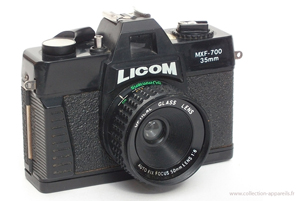 Reflex-like appearance. Reflex-like appearance.Viewfinder within the faux prism bulge. Advance lever. |
Licom MXF-700 |
Optical Glass Lens Auto Fix Focus 50mm Lens 1:6 |
||
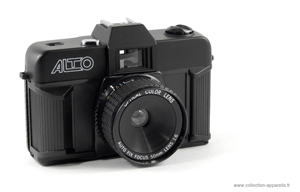 Reflex-like appearance. Reflex-like appearance.Viewfinder within the faux prism bulge. |
Alto | Optical Color Lens Auto Fix Focus 50mm Lens 1:6 |
||
| Deluxe-III | ||||
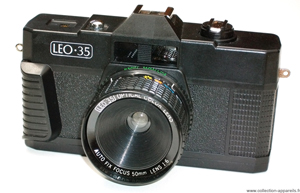 SLR-like shape. Two viewfinder windows aligned with the lens. |
Leo.35 | Leo. 35 Optical Color Lens Auto Fix Focus 50 mm Lens 1:6 |
||
 Reflex-like appearance. Reflex-like appearance.Finger rest at one end. Off-center viewfinder. Window obscured beneath the bulge. |
Eureka 2436 | New Color Optical Lens 1:6 f=50mm series 347859 |
347859 | |
| Weyburn F6 | ||||
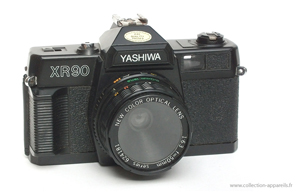 Reflex-like appearance. Reflex-like appearance.Off-center viewfinder. Finger rest on the right-hand side. |
Yashiwa XR90 |
New Color Optical Lens 1:6,3 f=50mm series 624181 |
624181 | |
__________
Premier Camera Co was established in Taiwan in 1983.
The Premier PC-90 has an “Optical Glass Lens”, whilst other similar cameras have an “Optical Lens” a “Color Optical Lens” or a “New Optical Lens” (all plastic?) There is even a “New Optical Glass Lens”.
In all cases the lens is a meniscus, and probably performs best at its smallest aperture. The various members of the family claim a maximum aperture of 5,6, 6, or 6,3 but the numbers make no sense. The aperture is just “variable”.
We can be reasonably sure that they were all made by Formosa Plastics Corporation (FPC) because the lens/shutter block is identical to other plastic cameras known to have been made by FPC. The four apertures and their weather symbols are essentially the same, the reference to the “50mm lens” is consistent (It isn’t), and many other details.
However there are slight differences to the others of its type. On this one the back is opened by raising the rewind crank, not with a slider in the base; there is a window in the back to see what film is loaded; and the plinth around the hot shoe curves into the top plate instead of forming a straight line.
It was not uncommon for new photographic companies in Taiwan to start by marketing cheap cameras made by FPC. Mikona, and New Taiwan Photographic Corporation (NTPC) did so too. These are distinct from the distributors like Arrow (Meikai), Kalimar, Kinusa, Lavec and Yunon.
The Premier PC-90 was also available with bright yellow top and bottom plates. (The Kalimar MX-1 had bright red top and bottom plates as an option)
This was probably Premier’s third camera of the type. It sold a PC-70 and a PC-80 which were similar but an older model, produced about 1983. The clue to the age of this one may be in the lens number 1985….
Cameras like this filled a demand in the USA for a 35 mm camera that could use electronic flash and be sold cheaply, or given away as a prize or in a promotion. The first were the Tougodu Meikai/Meica cameras made in Japan from 1963. We don’t know what this one cost, but a similar camera was offered in Weekly World News (13 February 1990) for $9.95. (A Kodak Instamatic X-15/15F cost about $15)

Interesting links or bibliography :
Add a link or element of bibliography, a picture taken with this camera, a picture of box or an ads about this camera
Your photos taken with the same camera:
Cameras from Ebay France (Premier ) (Uploaded each 3 hours)







